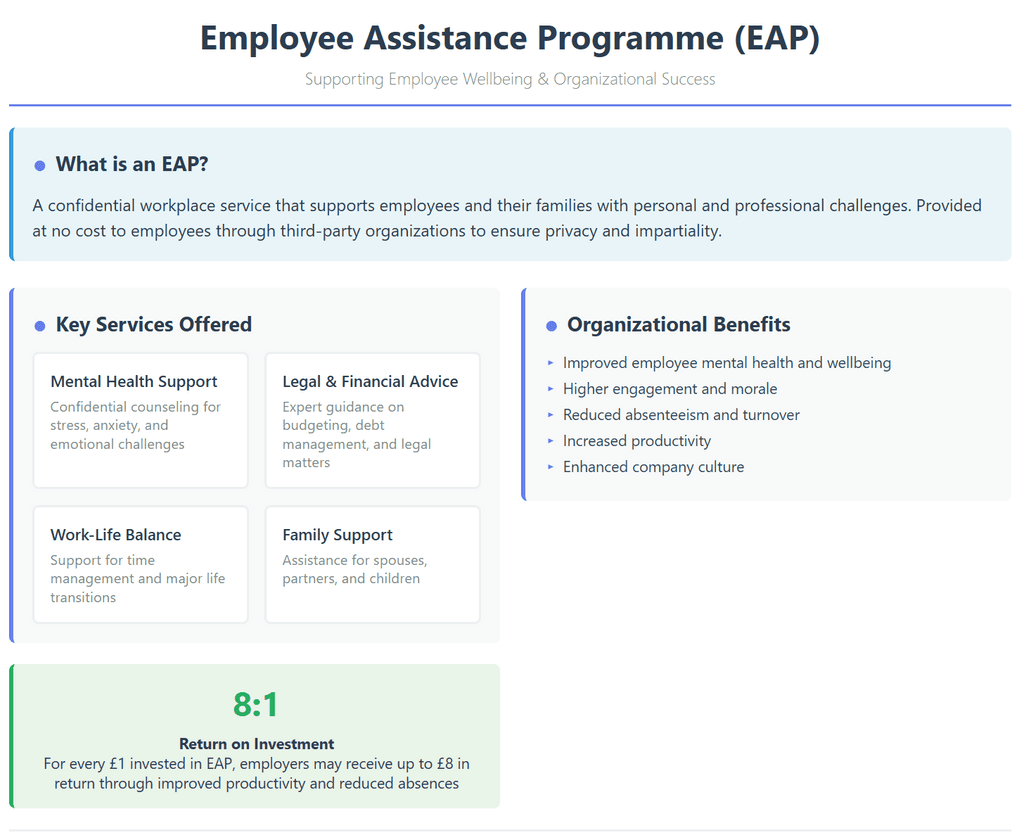In today’s fast-paced and high-pressure work environments, organizations must go beyond salary and perks to support their employees. One of the most effective tools for doing this is an Employee Assistance Programme (EAP).
An EAP is not just a benefit; it is a strategic resource that helps employees navigate personal and work-related challenges. This contributes directly to well-being, productivity, and retention.
What Is an Employee Assistance Programme (EAP)?
An Employee Assistance Programme (EAP) is a confidential workplace service designed to support employees and their immediate families with a wide range of personal and professional issues. These may include mental health concerns, stress, financial pressures, family responsibilities, and more.
EAPs are typically offered at no cost to employees and are provided by third-party organizations to ensure privacy and impartiality. The goal is to create a healthier, more resilient workforce both inside and outside the workplace.
Services Offered by Employee Assistance Programmes
Most EAPs offer a broad range of support services, including:
- Counseling and Mental Health Support
Confidential sessions with licensed professionals to help manage stress, anxiety, grief, or other emotional challenges. - Legal and Financial Advice
Access to experts who can assist with budgeting, debt management, legal matters, and estate planning. - Work-Life Balance Resources
Guidance on managing time, caregiving responsibilities, or adjusting to major life transitions. - Wellness and Life Skills Training
Workshops and resources covering topics such as resilience, mindfulness, nutrition, and healthy living. - Support for Family Members
Assistance for spouses, partners, or children dealing with personal or relational challenges.
How to Set Up an Employee Assistance Programme
Introducing an EAP into your organization involves several key steps:
- Assess Employee Needs
Conduct surveys or use HR data to identify common issues such as high stress levels, absenteeism, or financial concerns. - Choose the Right Provider
Select a provider with services that align with your company’s culture and employee demographics. - Communicate the Programme Effectively
Use internal emails, team meetings, intranet posts, and onboarding materials to announce the EAP. Emphasize that it is confidential, free, and available to employees and their families. - Promote the EAP Regularly
Reinforce awareness through ongoing communication. Use newsletters, posters, wellness events, and training sessions to keep the EAP top of mind.
Benefits and ROI of an EAP
An EAP offers measurable benefits to both employees and organizations:
- Improved Mental Health and Well-being
Employees receive timely support, reducing stress and burnout. - Higher Engagement and Morale
A supportive culture boosts loyalty and motivation. - Lower Absenteeism and Turnover
Addressing personal issues early can prevent prolonged absences or resignations. - Increased Productivity and Positive Culture
Employees who feel supported contribute more effectively and foster a healthier workplace dynamic.
Studies have shown that for every £1 invested in an EAP, employers may receive up to £8 in return through improved productivity and reduced absences.
Tips for Maximizing EAP Usage
To ensure employees take full advantage of the EAP, consider the following strategies:
- Promote the EAP Consistently
Use digital signage, reminders, and leadership messaging to keep the programme visible. - Offer Related Training
Host webinars or workshops on topics such as managing stress, building resilience, or balancing work and life. - Share Anonymous Success Stories
Testimonials from employees can reduce stigma and encourage participation. - Train Managers and Supervisors
Equip leaders with the knowledge to identify signs of distress and confidently refer team members to the EAP.

Employee Assistance Programme (EAP) FAQs
Is the Employee Assistance Programme (EAP) really confidential?
Yes. All sessions and communications with the EAP provider are fully confidential. Employers do not receive any personal details.
Who can access Employee Assistance Programme (EAP) services?
EAPs are usually available to all employees and often include immediate family members living in the same household.
How do I contact the Employee Assistance Programme (EAP) provider?
Contact details are typically available through your company intranet, HR portal, or orientation materials. Access is commonly provided via phone, web, or app.
What if I need more help than the EAP can provide?
EAPs can refer individuals to specialized long-term care or external services when additional support is required.
Conclusion and Call to Action
An Employee Assistance Programme (EAP) is a vital component of a modern workplace. It supports the holistic well-being of employees, reduces organizational risk, and enhances company culture.
If your organization does not yet offer an EAP, now is the time to consider it. If one is already in place, ensure it is well-communicated and actively used.
For more information, contact your HR department. Your well-being is a priority, and support is always available.
